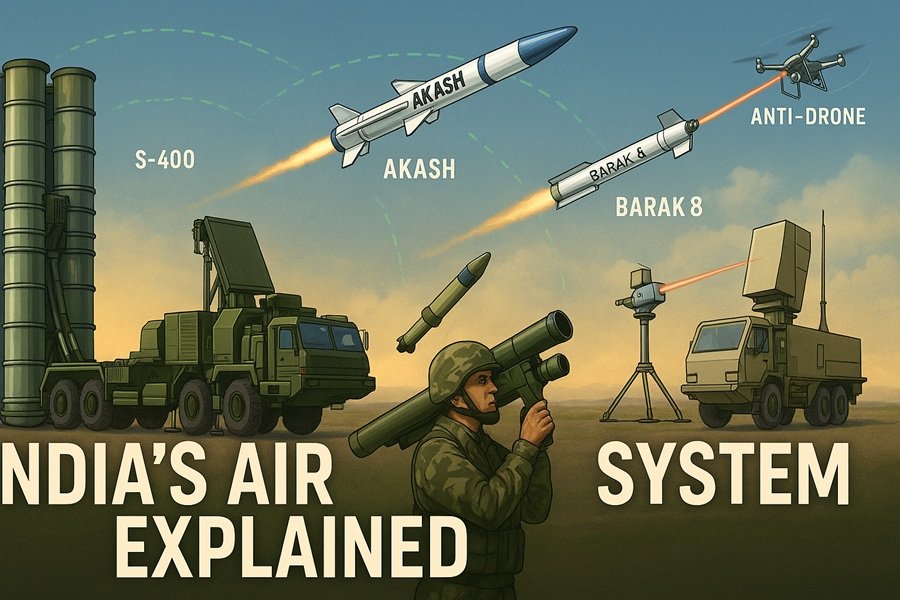
Introduction: Why India Needs a Multi-Layered Air Defense Shield
India, as one of the world’s most geopolitically active nations, faces security threats from both its western and northern borders. Given the increasing use of ballistic missiles, cruise missiles, drones, and stealth aircraft, India’s response has been to create a robust, multi-tiered air defense system.
This system aims to intercept and destroy enemy aerial threats at various altitudes and distances, ensuring maximum protection for civilian areas, military installations, and critical infrastructure.
The Structure of India’s Air Defense Shield: Layer-by-Layer
India’s air defense system is designed like an onion — with multiple layers intercepting threats at different ranges and altitudes. Here’s how the system is structured:
1. Long-Range Air Defense: Strategic Shield (Above 300 km)
S-400 Triumf
- Origin: Russia
- Range: Up to 400 km
- Altitude: Up to 30 km
- Radar Range: 600 km+
- Missile Types: 40N6 (400 km), 48N6 (250 km), 9M96E2 (120 km)
- Capability: Intercepts aircraft, cruise missiles, stealth fighters, ballistic missiles
Significance:
- Forms the backbone of India’s long-range defense.
- Deployed in Punjab, Assam, and along eastern sectors to cover both Pakistan and China.
- Can engage 80 targets simultaneously.
Ballistic Missile Defense (BMD) Phase-II
- Under development by DRDO
- Targets ICBMs and IRBMs (Intermediate-Range Ballistic Missiles)
- Intercepts threats at exo-atmospheric (outside atmosphere) ranges.
Read This: HQ-9 vs Akash vs S-400: Air Defense Systems
2. Medium-Range Air Defense (70–200 km)
Barak 8 / MR-SAM (Medium Range Surface-to-Air Missile)
- Jointly developed by DRDO and Israel Aerospace Industries (IAI)
- Range: 70–100 km
- Altitude: Up to 16 km
- Radar: EL/M-2084
- Capabilities: Intercepts aircraft, cruise missiles, UAVs
Variants:
- Land-based (IAF)
- Naval Barak-8 (deployed on destroyers like INS Kolkata)
- Army Variant for mobile air defense
XR-SAM (eXtra Long Range SAM)
- Under development
- Range: 250–350 km
- Will bridge the gap between S-400 and Barak-8
3. Short-Range Air Defense (25–70 km)
Akash Missile System
- Developed by DRDO
- Range: 25–40 km
- Speed: Mach 2.5
- Guidance: Command guidance with phased-array radar
- Target: Fighters, cruise missiles, drones
Variants:
- Akash-1S: Upgraded with seeker
- Akash-NG: Next-generation version with active seeker and improved mobility
Deployment: Along borders in Punjab, Arunachal, Rajasthan, and Eastern Air Command.
SPYDER (Surface-to-Air Python and Derby)
- Origin: Israel
- Range: 15–35 km
- Missiles: Python-5 (IR), Derby (active radar)
- Highly mobile and effective against low-flying threats
4. Very Short-Range Air Defense (VSHORAD – 0–6 km)
IGLA-S
- Origin: Russia
- Range: 6 km
- Infrared-guided MANPADS
- Deployed by infantry, especially in mountain regions like Ladakh and Arunachal
VSHORAD (Indigenous Program)
- Developed by DRDO
- Seeker-based system
- Replacing legacy IGLA systems
Specialized Air Defense Systems
1. Anti-Drone Systems
DRDO Anti-Drone System
- Capabilities:
- Detects micro drones within 3–5 km
- Jams GPS and C2 links
- Laser neutralization at 1–2 km
- Deployed during Republic Day, PM events, and LOC sectors
Private Sector Systems
- BEL and other startups are developing AI-based swarm detection and neutralization systems
2. Close-In Weapon Systems (CIWS)
AK-630
- Naval CIWS used on Indian warships
- Rate of Fire: 5000 rounds/min
- Final layer of defense against missiles and aircraft
DRDO’s CIWS Projects
- Laser-based systems and automated gun platforms are under development for land-based CIWS.
Read This: India’s BVR Missile Arsenal in 2025: A Comprehensive Overview
Naval Air Defense Systems
| System | Platform | Range | Type |
|---|---|---|---|
| Barak-8 | Destroyers, Frigates | 100 km | SAM |
| AK-630 | All major ships | 4 km | CIWS |
| MR-SAM Naval | INS Kolkata-class | 100 km | Area defense |
| VL-SRSAM | Under development | 40 km | Vertical launch, point defense |
Air Defense Radar Network
India’s success depends on an integrated sensor network:
Key Radars:
- Rohini & Revathi: 3D radar for low to medium altitude
- Swordfish: BMD radar with 600–1000 km tracking range
- Ashwini: Rotating AESA radar for hill/mountain coverage
- Arudhra (EL/M-2084): For Barak-8 & Akash systems
- AWACS/AEW&C: DRDO Netra & Israeli Phalcon systems
Integration Through IACCS
India has deployed a centralized command system known as:
IACCS – Integrated Air Command and Control System
Features:
- Real-time sensor fusion from radars, satellites, AWACS, and fighter jets
- Tracks hundreds of targets simultaneously
- Enables automated threat classification and interception orders
Future Developments in Indian Air Defense
1. BMD Phase-II
- Will intercept ICBMs at over 2000 km
- Dual-layer system: PDV Mk-II and AD-1/AD-2 missiles
2. Indigenous S-400 Competitor
- India aims to build a domestic equivalent of the S-400 via XR-SAM + BMD
3. Directed Energy Weapons (DEWs)
- Laser-based anti-drone & missile systems under DRDO development
4. Hypersonic Defense
- Research ongoing to counter hypersonic glide vehicles (HGVs)
Challenges to India’s Air Defense Strategy
- Cost: S-400 and future BMD systems are expensive and limited in numbers.
- Area Coverage: India’s vast borders mean some areas may remain exposed.
- Electronic Warfare: Modern EW systems can jam or deceive radars and missiles.
- Swarm Threats: Multiple low-cost drones may saturate defenses.
Comparison with Global Counterparts
| Country | System | Coverage |
|---|---|---|
| India | S-400, Akash, Barak-8, BMD | Multi-layer, emerging BMD |
| USA | THAAD, Patriot, Aegis | Advanced BMD and integrated C4ISR |
| China | HQ-9, S-400, HQ-22 | Effective long-range, but unknown EW resilience |
| Russia | S-400, S-300V, Pantsir | Strong layered system |
India is rapidly catching up, especially with indigenous radar and missile technologies.
Read This: India’s Missile Arsenal Explained: Strategic Might of the Subcontinent
India’s Ballistic Missile Defense (BMD) Program: Shielding Against Nuclear Threats
India’s Ballistic Missile Defense (BMD) program is a two-tiered, indigenous missile shield developed by the Defence Research and Development Organisation (DRDO) to intercept incoming ballistic missiles in the air — both inside and outside the Earth’s atmosphere.
Why BMD is Critical for India
With both Pakistan and China possessing a variety of short-range and intermediate-range ballistic missiles (SRBMs and IRBMs) — some nuclear-capable — the BMD system is designed to protect major cities like Delhi, Mumbai, and strategic military facilities. Its objective is not just retaliation, but denial of enemy first-strike capability.
Two-Tiered Structure of India’s BMD
Phase-I: Defense Against SRBMs (up to 2,000 km)
1. Prithvi Air Defence (PAD) Interceptor
- Intercept Altitude: Exo-atmospheric (50–80 km)
- Speed: Mach 5+
- Engages incoming missiles at high altitudes, outside the atmosphere.
2. Advanced Air Defence (AAD) Interceptor
- Intercept Altitude: Endo-atmospheric (15–30 km)
- Hits targets that evade PAD or are in terminal phase.
Together, these two create a double kill probability, increasing the chance of neutralizing incoming threats.
Phase-II: Intercepting IRBMs and ICBMs (2,000–5,000 km+)
Under advanced testing, Phase-II includes:
- AD-1 and AD-2 interceptors capable of taking down longer-range missiles and maneuvering re-entry vehicles (MaRVs).
- Integration with X-band and Swordfish LRTR (Long Range Tracking Radar).
- Designed to counter modern threats like Multiple Independently targetable Reentry Vehicles (MIRVs) and Hypersonic Glide Vehicles (HGVs).
Key Technologies in Indian BMD
| Component | Function |
|---|---|
| Swordfish Radar | Tracks targets up to 1,500 km |
| PDV & PDV Mk-II | Intercepts high-speed warheads in space |
| Command & Control | Real-time tracking and fire-control via IACCS |
| Mobile Launch Units | Rapid deployment to key zones |
Deployment and Coverage
Although India has tested the BMD system successfully multiple times, operational deployment is still limited. However, Delhi and Mumbai have been prioritized as Tier-I protected zones, with networked radar stations, interceptor silos, and command centers.
Future of India’s BMD System
India aims to evolve its BMD into a 360-degree, multi-layered, real-time interception grid. Key upgrades include:
- Integration with S-400 and upcoming XR-SAM
- Satellites for early warning (like RISAT, EMISAT)
- Space-based sensors and AI-driven battle management
Strategic Implications
India’s BMD program represents a major shift in strategic deterrence posture. While the doctrine still emphasizes “No First Use (NFU),” the BMD shield acts as a technological and psychological deterrent — reducing the adversary’s confidence in their missile strikes being successful.
Conclusion: India’s Air Defense System – A Growing Shield
India’s multi-layered air defense network is a strategic necessity in a region threatened by ballistic missile-capable neighbors, drone warfare, and stealth technology.
From S-400s and Akash missiles to anti-drone lasers, India is building a comprehensive aerial shield, integrating global imports with indigenous innovation.
As BMD programs mature, and XR-SAM and directed energy weapons enter service, India will stand among the few nations with a truly layered, integrated, and technologically advanced air defense system.







